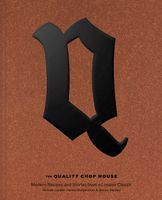Advertisement
Non–Prime Cuts
Appears in
By William Lander, Shaun Searley and Daniel Morgenthau
Published 2019
- SPIDER Bet you’ve not heard of this one before! The spider steak comes from inside the cow’s hip, and is heavily marbled with soft fats so that it resembles a web (hence the name). It’s quite a thin cut, so a hard and fast approach to cooking is definitely best. There are only two spider steaks per animal so it’s a rarity to see it on the butcher’s counter but do snap it up if you do, as it’s another maximum-flavour steak with a far lower price tag than a prime cut.
- FLATIRON Found under the shoulder blade, this cut has spent its life surrounded by fat and bone. Once this is carefully removed, the meat can be cut into thick, fat steaks. It benefits hugely from being cooked over charcoal, although it’s very lean so don’t cook more than medium rare. It has a lovely dense but soft texture. As with all non-primes, cutting against the grain is paramount to avoid an unpleasant chewy texture. You’ll see lines of the meat going one way (if these aren’t automatically obvious, tug the raw steak in different directions and you’ll see the grain of the muscle). Be sure to cut in the opposite direction to this.
- ONGLET This cut is actually classified as offal as it’s situated on the outside of the diaphragm. It benefits both from being a working muscle on the animal, which gives it lots of flavour, but also has all the lovely rich flavours you associate with offal. It’s a wonderful, unique and – if cooked medium rare – very lean steak. The grain is more prominent on onglet than other non-prime cuts, so just be sure to cut against this. We serve this on our lunch menu most days, finished with brown butter jus. It’s a very affordable cut and provides great bang for your buck.
- BAVETTE Taken from the flank (the breast area of the beast), this has a similar texture to onglet but is an actual muscle, surrounded by fat and sinew. If you get this carefully removed by a butcher, you’ll have a delicious robust steak. It’s not soft and buttery, but is more intensely meaty. A bavette benefits from a light marinade to tenderise the meat: we use tarragon, lemon and olive oil. But really any combination of aromatics, fat and acid will do.
- DENVER This comes from the chuck (the cow’s shoulder blade), an area traditionally associated with braising or roasting meat. But it makes some great steaks too. Cut from the centre of the underblade, it makes a robust, beefy steak, which needs heavy caramelisation and slow-cooking. The proteins within the muscle are tough, so although it looks similar to bavette or onglet, to cook it pink, leave it in a low temperature oven (90°C) for longer (20–30 minutes) to slowly break down the proteins.
- TRI–TIP This is found in the corner of the rump. It’s a nice affordable roasting joint, which, depending on size, usually serves between 2–3 people. It can be roasted whole and carved or cut into small steaks and served individually. If cooking whole, caramelise in a pan with butter and finish in an oven at a low temperature. Like the spider steak, there are only two tri-tips on every animal so it’s not always in stock, but if you are lucky enough to find it in a butcher’s shop then be sure to grab it.




